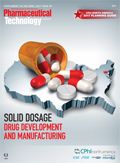Making PAT and Continuous Manufacturing Accessible
A venture between GEA and Siemens aims to familiarize more pharmaceutical companies with more modern control and continuous processing.
Anastasiya Aleksandrenko/ shutterstock.com

In December 2016, GEA and Siemens joined forces, introducing an integrated platform that combines Siemens’ Sipat process analytical technology (PAT) and GEA’s ConsiGma continuous processing model for oral solid-dosage manufacturing. The venture’s goal is to help advance the use of PAT and continuous production processes in the pharmaceutical industry. Both SIPAT and ConsiGma are used by several pharmaceutical manufacturers, including Janssen Pharmaceutica (1).
Harald Stahl, group director, application and strategy management, GEA, and Bart Moors, director, global account and project development life sciences, Siemens, shared some of the reasons for forming the venture and what they hope to accomplish.
Establishing proof-of-concept
PharmTech: Why did you decide to establish the venture?
Moors (Siemens): Together with several customers including Merck and GlaxoSmithKline (GSK), Siemens launched a PAT initiative back in 2007 to focus on non-continuous processes. Two years later, in the context of this collaboration, GSK scientists posed the question of whether the work could use the platform to look into the possibility of converting some batch processes to continuous. Subsequently, we founded a joint initiative with GEA to bring an integrated continuous tablet manufacturing line to the pharmaceutical and life-science industries and establish proof-of-concept.
Stahl (GEA): Historically, the pharmaceutical industry gathered process data from single samples, and that information was recorded and stored as a paper-based hard copy. When the development and implementation of automated systems began to gather speed in the mid-nineties, it became untenable to use paper systems to manage the vast amount of data that were generated. Although this was a shot in the arm for the pharmaceutical industry, other sectors, such as chemicals, petroleum, and the paper industry, were already familiar with the concept.
Companies such as Siemens had also gained experience in that area. So, according to the principal goal of the PAT imperative-to design and develop processes that can consistently ensure a predefined quality at the end of the manufacturing process-we had to ask: What do we do with all the data, and how can we both reduce risk and improve quality? GSK was our first customer.
PharmTech: Will companies license the technology, or will they outsource work to the venture?
Stahl (GEA): At the moment, no legal infrastructure has been implemented. It’s a non-exclusive collaboration between two companies. Of course, like any project, the other company is the preferred partner, but we have more altruistic aims. The collaboration will deliver both production benefits, in terms of reduced project execution risk, higher quality and cost-effective manufacturing, and customer benefits in the form of seamlessly integrated technologies, expertise, and support.
PharmTech: What response are you seeing so far?
Stahl (GEA): Smaller companies in particular seem to appreciate that [the venture partners’] experience making continuous process development work for other companies could make it easier and less risky for them to move into continuous processing. We’re also seeing considerable interest from contract manufacturing organizations (CMOs). In recent years, regulatory pressure and changing approaches to drug development have spurred the pharmaceutical industry to look beyond its batch processing history.
PharmTech: What do you see, in general, as the major challenges in promoting the shift from batch to continuous processing in pharma?
Stahl (GEA): For more than 20 years, the batch-based production of blockbuster solid-dosage forms dominated the industry. Profitability was such that companies were not incentivized to innovate or risk developing new manufacturing technology. However, in the post-blockbuster era, it is increasingly recognized that material costs during drug development are significant, making time-to-market even more critical. New drug products are likely to be manufactured in much smaller quantities, and for novel treatments, the development of a commercial manufacturing process is not guaranteed.
A single continuous manufacturing (CM) line can be used to process any volume of product, from small quantities for formulation development and design of experiments, through to clinical trials and the full-scale manufacture of new chemical entities and high-volume generics without the need for investment in costly new equipment or a dedicated plant. Product output is rapid, scalable, and can be adjusted according to need, such as in the event of major disease outbreaks.
The biggest driver is reducing cost, of course. However, other goals are also at work, including the desire for faster throughput, the need to use less API during development and scale-up, the need to reduce GMP space and out-of-specification material and to improve flexibility. There is, however, some uncertainty about registration. Although major authorities such as the European Medicines Agency FDA are very supportive, some pharmaceutical companies are still uncertain about how CM-made products will be accepted in smaller countries.
Reference
1. “Factory of the Future: Janssen Pharmaceutica Case Study,” azom.com.
Article Details
Pharmaceutical Technology
Supplement: Solid Dosage Drug Development and Manufacturing
Vol. 41
April 2017
Pages: s30–s31
Citation
When referring to this article, please cite it as A. Shanley, "Making PAT and Continuous Manufacturing Accessible," Pharmaceutical Technology Solid Dosage Drug Development and Manufacturing Supplement (April 2017).

Pharmaceutical Tariffs Are Imminent: How Industry is Bracing for Impact
April 16th 2025On April 14, 2025, the Trump Administration launched a national security-driven investigation into pharmaceuticals, a move that will likely result in tariffs being placed on pharmaceutical drugs, ingredients, and other components that are imported from outside of the United States.
Drug Solutions Podcast: A Closer Look at mRNA in Oncology and Vaccines
April 30th 2024In this episode fo the Drug Solutions Podcast, etherna’s vice-president of Technology and Innovation, Stefaan De Koker, discusses the merits and challenges of using mRNA as the foundation for therapeutics in oncology as well as for vaccines.